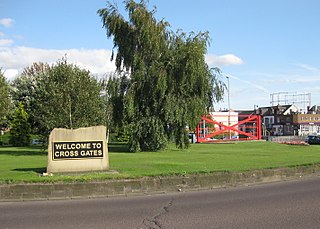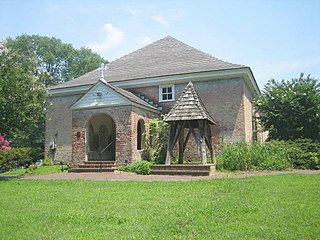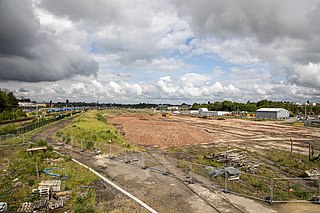
Clifton is a suburb of York in the unitary authority area of the City of York, in North Yorkshire, England about 1+1⁄2 miles from the city centre. The A19, passes north out of York through Clifton.

Acomb, is a village and suburb within the City of York unitary authority area, in North Yorkshire, England, to the western side of York. It covers the site of the original village of the same name, which is mentioned in the Domesday Book of 1086. It is bordered by the suburbs of Holgate, to the east, Clifton, to the north and Woodthorpe to the south. The boundary to the west abuts the fields close to the A1237, York Outer Ring Road.

Osbaldwick is a village and civil parish in the unitary authority of the City of York in North Yorkshire, England. The population of the civil parish as taken at the 2011 census was 2,902. It has been in existence since at least the 11th century, and was declared a conservation area in 1978. It is the burial place of the nun Mary Ward.

Linslade is an area in the civil parish of Leighton-Linslade, in the Central Bedfordshire unitary authority area of Bedfordshire, England. The original village was at Old Linslade on the banks of the River Ouzel. A new settlement called Linslade grew up a mile to the south of Old Linslade in the 19th century, particularly following the opening of Leighton Buzzard railway station there in 1838. Linslade now forms part of the urban area of Leighton Buzzard.

Hemsworth is a town and civil parish in the City of Wakefield, West Yorkshire, England. Historically within the West Riding of Yorkshire and had a population of 13,311 at the 2001 census, with it increasing to 13,533 at the 2011 Census.

Clay Cross is a town and a civil parish in the North East Derbyshire district of Derbyshire, England. It is a former industrial and mining town, about 5 miles (8.0 km) south of Chesterfield. It is directly on the A61. Surrounding settlements include North Wingfield, Tupton, Pilsley and Ashover.

Cross Gates is a suburb in east Leeds, West Yorkshire, England.

St. Paul's Chapel is a chapel building of Trinity Church, an episcopal parish, located at 209 Broadway, between Fulton Street and Vesey Street, in Lower Manhattan, New York City. Built in 1766, it is the oldest surviving church building in Manhattan and one of the nation's most well renowned examples of Late Georgian church architecture.
York had around 45 parish churches in 1300. Twenty survive, in whole or in part, a number surpassed in England only by Norwich, and 12 are used for worship. This article consists of a list of medieval churches which still exist in whole or in part, and a list of medieval churches which are known to have existed in the past but have been completely demolished.

St Thomas the Martyr Church is a Church of England parish church of the Anglo-Catholic tradition, in Oxford, England, near Oxford railway station in Osney. It is located between Becket Street to the west and Hollybush Row to the east, with St Thomas Street opposite.

St. John's Church, St. John's Episcopal Church, or St. John's Episcopal Church, Broad Creek, is a historic Episcopal church located at 9801 Livingston Road in Fort Washington, Prince George's County, Maryland. It is a rectangular Flemish bond brick structure with a bell hipped roof. The interior features a barrel vaulted ceiling with an intricate support system.

St John the Evangelist's Church is the Church of England parish church of Burgess Hill, West Sussex, England. It is a Gothic Revival church built of local bricks. It was consecrated in 1863 and was the town's first Church of England church. Since then it has administered several other churches in the town as either mission chapels or daughter churches, but all have either closed or been given their own parishes. The church is a Grade II* Listed Building.

St. Barnabas Episcopal Church is a former church building in the Episcopal Diocese of Iowa in Montrose, Iowa, United States. It was listed on the National Register of Historic Places in 1986. The building is now called St. Barnabas Wedding Chapel.

Holgate is a suburb of York in the ceremonial county of North Yorkshire, England. It is located about 1 mile west of Micklegate Bar in the city walls. Holgate is also the name of an electoral ward in the City of York unitary authority. The ward is currently bounded by the River Ouse from Scarborough Bridge to Ouse Acres on its northern boundary. Carr Lane and Ouse Acres on one side, and the intersection of York Road and Acomb Road on the other, make up its western boundary. The remainder of the southern boundary follows Moorgate and Holgate Beck to the East Coast Main Line railway which completes the eastern boundary as far as the River Ouse/Scarborough Bridge.
St. Denis Church is a Roman Catholic parish church under the authority of the Roman Catholic Archdiocese of New York, located in Hopewell Junction, Dutchess County, New York. It was established in 1899 as a parish; it had previously been established a mission of St. Mary in Wappingers Falls.

St Barnabas Bethnal Green is a late 19th-century church in Bow in London, England. It is an Anglican church in the Diocese of London. The church is at the junction of Roman Road and Grove Road in the Bow West ward of London Borough of Tower Hamlets.

St Saviour's Anglican Church is a heritage-listed former church building at 26 Hynes Street, South Johnstone, Cassowary Coast Region, Queensland, Australia. It was built from 1938 to 1939 by Mose Romano. It was added to the Queensland Heritage Register on 24 September 2004.

St Mark's Church, Silvertown or St Mark's Church, Victoria Docks is a former church building in Silvertown in east London, located on North Woolwich Road. It takes one of its names from the nearby Royal Docks. It was listed as Grade II* in 1971 and now houses the Brick Lane Music Hall.

St Stephen's Church is a Church of England church on Castlebar Hill in Ealing. It was founded in 1867 as a mission and is now established as a separate parish. The first church building was a temporary iron church which was then replaced in 1876 by a substantial Victorian Gothic stone building which is now Grade II listed. Subsidence made that unsafe and it was deconsecrated in 1979. It has been converted to flats but still forms the landmark centrepiece of the St Stephen's Conservation Area. The congregation now holds services on the site of the church hall which has been redeveloped as the third church building and community centre.

York Central is a development on former railway land to the west of York railway station in York, England. The 45-hectare (110-acre) site is one of the largest brownfield developments in England. York Central is sometimes referred to as The Teardrop, because of the shape the development takes when viewed from above. Work on York Central started in 2021, and is expected to deliver 2,500 homes and 1,200,000 square feet (110,000 m2) of commercial space.



















